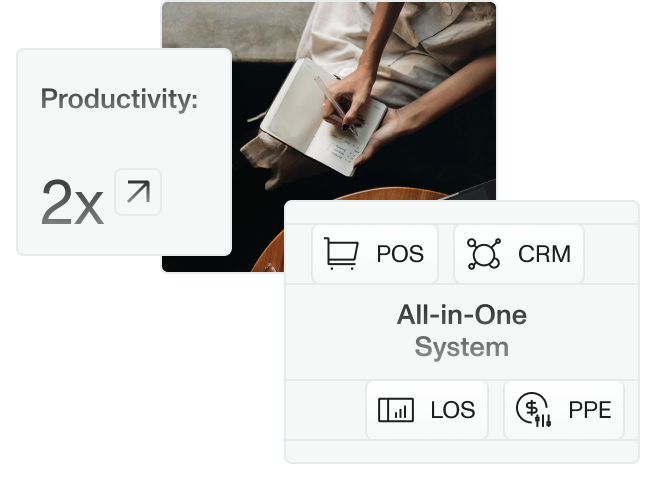Balancing risk and reward makes or breaks a loan officer or loan origination business. Effective mortgage loan officer risk management can be what separates good from great when it comes to navigating the various complexities of this industry. From market fluctuations to regulatory changes, loan officers experience daily battles with risks that require careful mitigation, an expert understanding of the industry, and a nose for compliance. Leaning into prevention tactics for these risks and implementing targeted strategies to combat them can help mortgage professionals protect their client’s investments and their company’s operations.
This article marinates on the primary risks mortgage originators face, assesses their impact, and outlines key strategies for avoiding them.
What are the Primary Risks?
There are several risks that, if unmanaged or ignored, can derail a successful loan originator or loan origination business. Four primary risks stand out amongst the rest. Let’s dig into them:
- Market Fluctuations: Economic changes and interest rate volatility can dramatically impact a borrower’s ability to afford a mortgage, as well as the market demand for loans. For mortgage loan officers, knowing or even predicting these fluctuations can protect borrowers and lenders and set you up for future success.
- Borrower Defaults: Ensuring a borrower’s creditworthiness and sticking to that gut instinct should always be a top priority. Defaults generally occur when borrowers cannot meet their payment obligations, often due to employment instability or unforeseen financial difficulties. Managing this risk effectively is a critical part of loan origination risk management.
- Regulatory Changes: Everyone in the industry is beholden to compliance. That’s local, state, and federal regulations, which include laws like RESPA, TILA, and the Dodd-Frank Act. These differing regulations and any changes or adjustments to them can impact loan origination, documentation, and borrower disclosures. Failure to adhere to these regulations can lead to significant penalties, making regulatory compliance for mortgage officers a major aspect of risk management.
- Operational Errors: Human errors, process inefficiencies, and even fraud can occur within the loan origination process. Whether intentional or not, mistakes and oversights can lead to missed compliance steps, causing costly delays, or worse – fines and penalties.
Identifying and Assessing Risks
Effective mortgage industry risk assessment begins with identifying and objectively evaluating potential risks or aspiring borrowers with these three strategies.
- Conducting Risk Assessments: Mortgage loan officers should regularly assess loan risks, particularly during volatile economic periods. Risk assessments can highlight borrower vulnerabilities, allowing officers to mitigate these issues or deny a loan proactively.
- Utilizing Risk Assessment Tools: Software solutions are essential for tracking and analyzing potential risks and avoiding mistakes. By implementing digital risk assessment tools, mortgage professionals can streamline their assessments, organize their data, and monitor real-time risk indicators. An excellent place to start is with Sonar’s three-in-one POS, LOS, and PPE tool.
- Analyzing Historical Data: Studying past loan defaults, regulatory infractions, and market dips provides valuable insights for mortgage loan officer risk management. Historical data can paint the picture for mortgage professionals to anticipate potential challenges and get to work finding preemptive solutions.
Best Practices for Mitigating Risks
Mortgage risk mitigation requires a proactive approach because it may already be too late if you find yourself having to react.
Below are three successful strategies mortgage loan officers implement to reduce their exposure to risks and successfully position themselves and their companies.
- Implementing Robust Screening Processes: Templatized, objective, and thorough credit checks, employment verifications, and debt-to-income assessments ensure borrowers are adequately screened. This can reduce the likelihood of default and support a broader loan portfolio.
- Standardizing Procedures: Establishing company-wide, nonnegotiable standards, checklists, and guidelines for every step of the loan origination process minimizes the risk of human error and enhances compliance with regulatory requirements. It also helps to identify technological solutions like Sonar that can help automate mundane tasks that lend themselves to human error.
- Training and Education: Loan officers must continue to be trained on mortgage risk mitigation strategies. Regular education on updated regulations, emerging risks, and best practices keeps teams equipped to handle challenges the second they appear.
Leveraging Technology for Risk Management
Technology can be the star point guard in modern loan origination risk management, helping set up your staff and team to be the best, most knowledgeable versions of themselves. Let’s not bury the lead; properly using technology means your staff isn’t focused on mundane tasks but is spending time on more important matters like managing customer relationships.
Let’s break down the specific advantages of technology in risk management for loan origination.
- Automated Systems: Automation tools minimize human error by standardizing repetitive tasks, such as data entry and document verification. Sonar’s solutions, for example, use automated workflows that reduce bottlenecks and enhance accuracy across the board.
- Predictive Analytics: Predictive analytics lets loan officers project potential risks based on patterns in historical and/or current economic data, borrower behavior, and market trends. Predictive tools allow for more strategic decision-making and, by extension, better mortgage loan officer risk management.
- Cybersecurity Measures: With sensitive borrower information at stake and hackers only getting more sophisticated, cybersecurity protocols are essential. Protecting data against breaches and fraud ensures compliance, builds borrower trust, and helps create a positive long-term reputation for your company.
Regulatory Compliance
This article has already touched on the importance of mortgage loan officer risk management and how staying abreast of regulatory changes can be a strategy for advancing your business.
Well, it starts with remembering that your customers look to you as experts. So, the more you can demonstrate a keen understanding of compliance, the more likely you are to earn and keep more business.
Here are three easy ways to be that fountain of knowledge for your customers.
- Understanding Key Regulations: Mortgage officers must be well-versed in the law. We mentioned RESPA, TILA, and the Dodd-Frank Act earlier. These regulations guide every aspect of loan origination, from borrower disclosures to fair lending practices.
- Regular Compliance Audits: Conducting internal audits informs mortgage professionals of compliance gaps and ensures they meet all regulatory standards.
- Staying Updated: With constant changes, tweaks, and regionality in regulations, staying informed should be a top priority. Having a list of reliable sources and news outlets can ensure you’re on top of compliance standards under the latest regulatory standards.
Building a Culture of Risk Awareness
Lastly, if you’re a decision-maker or owner of a loan origination business, an effective risk mitigation strategy can be as simple as having a culture of risk awareness. Building risk awareness into the fabric of your company will make it so that your team will stop and ask themselves the important questions, “Is this compliant?” or “Do I need to double-check the new law that went into effect last week?”
It doesn’t happen overnight, but here are some ways to build a culture of risk awareness.
- Encouraging Open Communication: Schedule lunch-and-learns, bring in speakers, or encourage open dialogue within the company.
- Creating a Risk Management Framework: A well-defined framework guides mortgage professionals in assessing, mitigating, and reporting risks within the company. This systematic approach will help your group identify more issues before they become a problem, not after.
- Involving All Team Members: Educate and inspire your team members to embrace compliance as a pillar of success at their job. When everyone understands the mission and their respective roles and responsibilities in managing risks, you are more likely to avoid errors.
Mortgage loan officer risk management is a short-term and long-term effort that begins with first understanding the primary risks. Mortgage professionals can effectively mitigate pitfalls and rat traps by conducting thorough assessments, utilizing technology, and building a culture of risk awareness.
If you want to improve your company’s technology, Sonar offers solutions to support loan officers in their risk management efforts. We automate mundane processes while ensuring compliance, which empowers mortgage professionals to operate confidently in a complex and constantly evolving industry.
Want to learn more? Request a demo and take a step closer to making compliance easier and more accessible for you and your staff.







